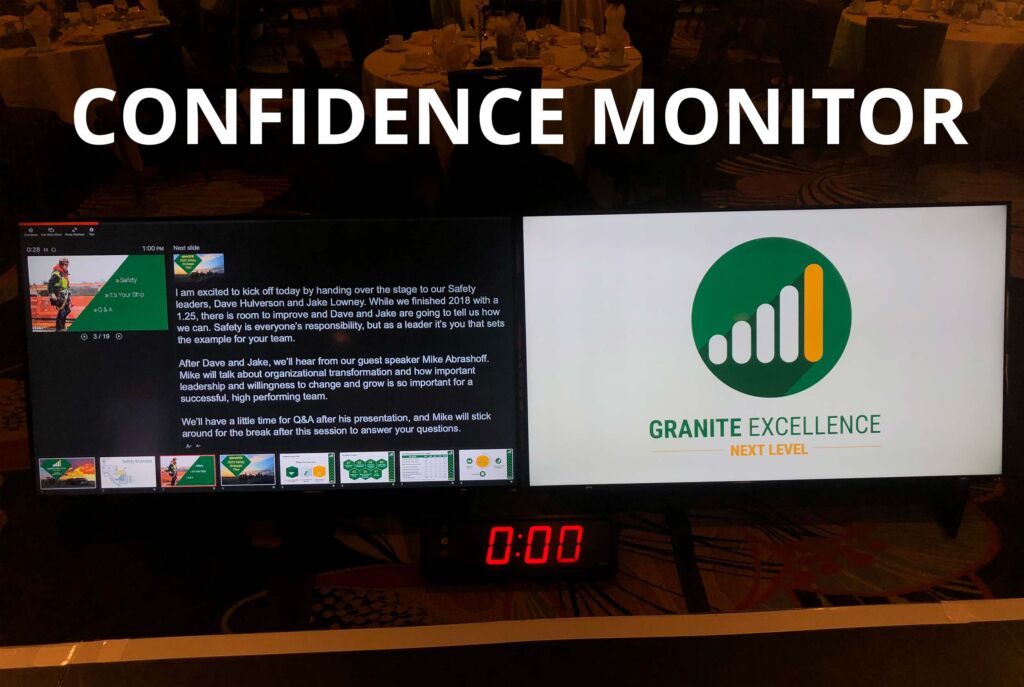If you’re a seasoned professional or a first-time speaker presenting in front of a live audience can be a daunting task. In addition to building a presentation, communicating with event staff, and understanding the Audio Visual technical jargon you have to be sure you’re clearly articulating your content to the attendees. It can be OVERWHELMING!
But worry not! We put together a list of some Tips & Tricks to help ease some of the stress and make sure your presentation runs smoothly.
Building your Presentation:
Before you begin to build your presentation be sure you are in 16:9 format. Click here to read how to change aspect ratio in PowerPoint and Keynote.
Less is more
Whenever possible, limit the number of slides you use in your presentation. Use images, graphs, or key words and phrases as emphasis to your content. Avoid adding lengthy paragraphs to slides. It is difficult for your audience to read and listen to your presentation simultaneously.
Fonts
Fonts can make or break your presentation. Sizes smaller than 30pt can make it difficult for your attendees to read your content. It is also important to choose a legible font that can be clearly read from a distance. A good way to test this is to play back your presentation on a laptop or PC while standing 8’ to 10’ from the screen. If you have difficulty reading your content you should consider increasing your font size.
Animations
Avoid animated or complicated transitions. These add time to your presentation and can distract your audience. However, some animation, like flying in text or images on specific slides, can be used sparingly to add some pizazz. Remember – animations are there to ENHANCE your presentation, not to ENTERTAIN your attendees.
Images
Whenever possible, avoid adding low resolution images to your presentation. Your content will appear pixelated and illegible when displayed on a large projection screen.
Videos
When playing back video content from any presentation software ALWAYS be sure you have a copy of the video file saved in the same folder as the presentation! It is also imperative that the presentation and the video are saved to the computer that is being used to run the presentation.
Running your presentation off an external storage device can cause videos, animations and transitions to stutter or freeze.
Contact Information
Build a slide for the end of your presentation with your name and email address. Ask attendees with additional questions to direct them to the email address provided.
The Day of your Presentation:
Before you Arrive
Save your presentation onto at least two portable storage drives formatted to exFat. This formatting type works on both Mac and Windows computers. If you need help on formatting drives click here. It’s also a good idea to upload your presentation to a cloud-based file storage system like DropBox before you arrive onsite. Your AV team can then flag any potential issues before you arrive.
BE EARLY! Give yourself at least 15 before you begin to find the room in which you’re presenting and to test your presentation with the AV Company.
Check ALL videos and images thoroughly. If you have audio built into the presentation make sure it plays back smoothly and is audible throughout the room.
Presenter Notes
If you intend to use presenter notes it is recommended that you inform your event planner or Audio Visual staff ahead of time. It may require a secondary laptop to display your notes in presenter view on the confidence monitor. It is also important to limit the amount of information you add to the notes section. Use bullet points or key phrases in place of lengthy paragraphs.
Microphone Use
When speaking from a lectern or podium try to speak directly into the microphone. Adjust the microphone so it’s no further than 6” from your mouth when speaking. If you are using a handheld microphone keep the mic pointed directly toward your mouth. Lavalier or “lapel” mics can be an excellent option, but need to be positioned close to the presenter’s mouth. Shirts or jackets with high collars will allow for the most effective placement of this type of microphone. Be sure to consult with the event organizer ahead of time to learn what types of microphones will be available for you at the venue. If you have specific microphone needs it may be worth purchasing your own or researching a local Audio Visual rental company near your event.
Computers
Some venues or AV companies will provide speakers with a “presentation laptop”. Always run a test to make sure your presentation is compatible with the laptop provided.
If you plan on using your personal laptop be sure to bring your power supply. It is never a good idea to rely on battery power. If your computer doesn’t have a standard HDMI output you may also want to purchase a few video adapters that will allow you to connect your machine to the venue’s video system.

